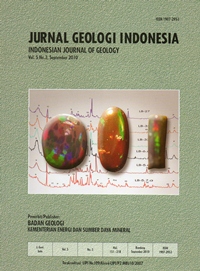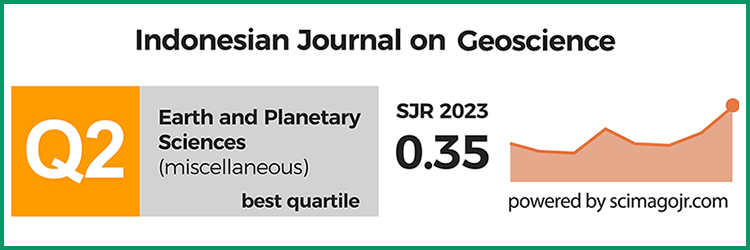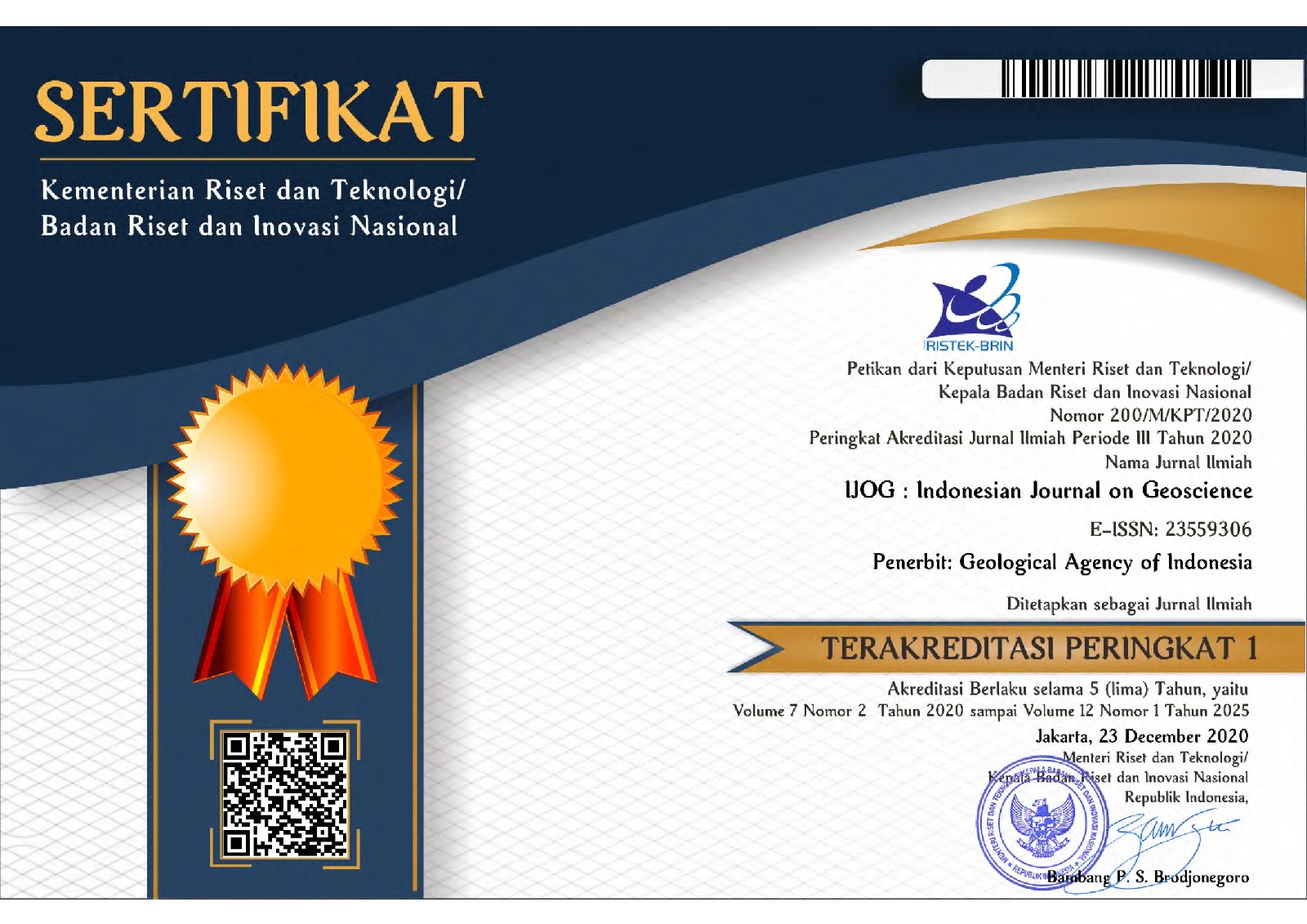Model Mineralisasi Pembentukan Opal Banten
DOI:
https://doi.org/10.17014/ijog.5.3.151-170Keywords:
opal, genetic, mineralization model, BantenAbstract
Opal is a beautiful precious gemstone that is equal or more valuable than diamond. In Indonesia, precious opal is found at the Lebak Regency, Province of Banten. Banten’s opal widely has been recognized due to its beautiful opalescence. This paper is a review of the last research; preliminary study of Banten’s opal, characteristics of opal-CT and determining of opal type from geochemical data, added by new data to compile concept and to make mineralization model. In order to fulfill these targets, field geology research and analysis of mineralog/gemology, petrography, X-RD, and major and trace element geochemistry have been done. The Banten’s opal is opal-CT showing opalescence (play of colour), weathering, and leaching silica from volcanic glass by dark grey claystone hosted. Mineralization model is divided into three periods; at Early Pliocene volcanic clastic sediments rich in volcanic glass occured as fluvial sediments. Afterwards, at Late Pliocene - Pleistocene folding, weathering and leaching of silica took place. Intensive jointing, faulting, and folding quickened weathering and leaching processes to formed opal at limb of anticline through Holocene. The prospecting area of Banten’s opal is in tuff unit with intercalation of conglomerate or pumiceous breccia, at limb of anticline. The host rock of opal is dark grey claystone which underlies polimict conglomerate/pebbly sandstone sequence with cross stratification, imbricated, and erossional stucture; more than 8 m deep.
References
Ansori, C., Siregar, S., dan Sumantri, T.A.F., 2003. Preliminary Study of Opal Genesis at Lebak Regency, Banten. Proceedings Internasional Conference On Mineral and Energy Resources Management UPN ‘Veteran’, Yogyakarta.
Ansori, C., Harijoko, A., dan Warmada, I. W., 2006. Characteristics and Genesis of Precious Opal-CT from Banten, Java, Indonesia. Proceedings The 8 th Field Wise Seminar and 3nd Internasional Symposium on Geological Engineering Education; Department of Geological Engineering Faculty of Engineering, Gadjahmada University. Yogyakarta, h. 294-304, GLB: 04788.
Ansori, C., 2008. Penentuan Tipe Opal Banten Berdasarkan Analisis Geokimia. Jurnal Bahan Galian Industri, Puslitbang Teknologi Mineral dan Batubara (TEKMIRA) - ESDM, Bandung, 12 (34), h. 20-31.
Anonim, 1981. Indonesia Geothermal Gradient Map. PERTAMINA. Jakarta.
Harijanto, S., 1992. Permata dan Batu Permata. Publikasi Khusus Direktorat Sumberdaya Mineral, Dirjen Geologi Dan Sumberdaya Mineral Departemen Pertambangan. Bandung.
Hulburt, C.S. dan Switzer, G.S., 1979. Gemologi. John Willey Publication. New York – Brisbane, 304 h.
Horton, D., 2002. Australian Sedimentary Opal - Why is Australia Unique. Australian Gemologist, 21, h.287-294.
Jones J.B. dan Segnit E.R., 1971. The Nature of Opal, Nomenclature and Constituent Phases. Journal of Geological Society, Australia, 18(1), h.57 – 68. DOI:10.1080/00167617108728743
Kerr, P. F., 1959. Optical Mineralogy. Mc. Graw Hill Book Company, Inc. New York,Toronto, London, 441 h.
Loughnan, F.C., 1969. Chemical Weathering of Silicate Mineral. American Elsiever Publishing Company. Inc. New York, 546 h
Pewkliang, B., Pring, A., dan Brugger J., 2004. Opalisation of Fossil Bone and Wood: Clues to the Formation of Precious Opal. Regolith, CRC LEME, Australia, h.264-268.
Rusmana, E., Suwitodirdjo K., dan Suharsono, 1991. Geologi Lembar Serang, Jawa, skala 1 : 100.000. Pusat Penelitian dan Pengembangan Geologi,Bandung.
Rollingson, H., 1993. Using Geochemical Data: evaluation, presentation, interpretation. Longman Publisher, Singapore, 352 h. DOI:10.4324/9781315845548
Schmid, R., 1981. Descriptive Nomenclature and Classification of Pyroclastic Deposits and Fragments.Dalam: Fisher R.V. dan Schmincke, H.U., (eds.), Pyroclastic Rock. Springer Verlag. Tokyo, 472 h.
Syahbuddin, A., Sumantri, Y.R., Kartanegara, L., dan Asikin, S., 1987. Pola perkembangan tektonik Cekungan Rangkasbitung, Jawa Barat, selama Tersier sebagai akibat dari letaknya yang berada di antara Cekungan Bogor, Cekungan Jawa Barat Daya dan Cekungan Sumatera Selatan. Prosiding PIT XV, IAGI. Yogyakarta, h.328-352.
Utada, M., 2001. Zeolite in Burial Diagenesis and Low Grade Metamorphic Rocks. Review in Mineralogy and Geochemistry, 45, Natural Zeolite:Occurrence, Properties, Application. Mineralogical Society of America and Geochemical Society. DOI:10.2138/rmg.2001.45.9
www.EarthRef.org, 2005 .GERM Reservoar Database.



















